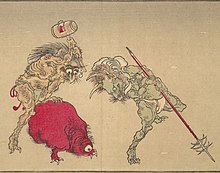
| Part of a series on |
| Japanese mythology and folklore |
|---|
 |
| Mythic texts |
| Divinities |
| Legendary creatures and urban legends |
| Mythical and sacred locations |
| Sacred objects |
| Shintō and Buddhism |
Yōkai (妖怪, "strange apparition") are a class of supernatural entities and spirits in Japanese folklore. The kanji representation of the word yōkai comprises two characters that both mean "suspicious, doubtful", and while the Japanese name is simply the Japanese transliteration or pronunciation of the Chinese term yaoguai (which designates similarly strange creatures), some Japanese commentators argue that the word yōkai has taken on multiple different meanings particular to a Japanese context, including referring to a large number of uniquely Japanese creatures.
Yōkai are also referred to as ayakashi (あやかし), mononoke (物の怪) or mamono (魔物). However, most Japanese generally think of the two loose classes of spirits as highly different, although some academics and Shinto practitioners acknowledge similarities within the seeming dichotomy between the natures of them and most kami, which are generally regarded as relatively beneficent in comparison, and class the two as ultimately the same type of spirits of nature or of a mythological realm. Their behavior can range from malevolent or mischievous to benevolent to humans.
Yōkai often have animal-like features (such as the kappa, depicted as appearing similar to a turtle, and the tengu, commonly depicted with wings), but may also appear humanoid in appearance, such as the kuchisake-onna (口裂け女). Some yōkai resemble inanimate objects (such as the tsukumogami), while others have no discernible shape. Yōkai are typically described as having spiritual or supernatural abilities, with shapeshifting being the most common trait associated with them. Yōkai that shapeshift are known as bakemono (化け物) or obake (お化け).
Japanese folklorists and historians explain yōkai as personifications of "supernatural or unaccountable phenomena to their informants". In the Edo period (1603 to 1868), many artists, such as Toriyama Sekien (1712-1788), invented new yōkai by taking inspiration from folk-tales or purely from their own imagination. Today, several such yōkai (such as the amikiri) are mistakenly thought to originate in more traditional folklore.
Concept
The concept of yōkai, their causes and phenomena related to them varies greatly throughout Japanese culture and historical periods; typically, the older the time period, the higher the number of phenomena deemed to be supernatural and the result of yōkai. According to Japanese ideas of animism, spirit-like entities were believed to reside in all things, including natural phenomena and objects. Such spirits possessed emotions and personalities: peaceful spirits were known as nigi-mitama, who brought good fortune; violent spirits, known as ara-mitama, brought ill fortune, such as illness and natural disasters. Neither type of spirit was considered to be yōkai.
One's ancestors and particularly respected departed elders could also be deemed to be nigi-mitama, accruing status as protective spirits who brought fortune to those who worshipped them. Animals, objects and natural features or phenomena were also venerated as nigi-mitama or propitiated as ara-mitama depending on the area.
Despite the existence of harmful spirits, rituals for converting ara-mitama into nigi-mitama were performed, aiming to quell maleficent spirits, prevent misfortune and alleviate the fear arising from phenomena and events that otherwise had no explanation. The ritual for converting ara-mitama into nigi-mitama was known as the chinkon (鎮魂, lit. 'the calming of the spirits' or 'requiem'). Chinkon rituals for ara-mitama that failed to achieve deification as benevolent spirits, whether through a lack of sufficient veneration or through losing worshippers and thus their divinity, became yōkai.
Over time, phenomena and events thought to be supernatural became fewer and fewer, with the depictions of yōkai in picture scrolls and paintings beginning to standardize, evolving more into caricatures than fearsome spiritual entities. Elements of the tales and legends surrounding yōkai began to be depicted in public entertainment, beginning as early as the Middle Ages in Japan. During and following the Edo period, the mythology and lore of yōkai became more defined and formalized.
-
 Chōchin-oiwa by Katsushika Hokusai
Chōchin-oiwa by Katsushika Hokusai
-
 Kidōmaru by Utagawa Kuniyoshi
Kidōmaru by Utagawa Kuniyoshi
-
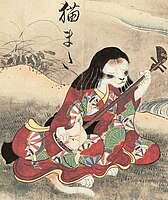 Nekomata from the Hyakkai Zukan by Sawaki Suushi
Nekomata from the Hyakkai Zukan by Sawaki Suushi
-
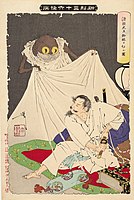 Tsuchigumo from the Shinkei Sanjurokkai Sen (新形三十六怪撰) by Tsukioka Yoshitoshi
Tsuchigumo from the Shinkei Sanjurokkai Sen (新形三十六怪撰) by Tsukioka Yoshitoshi
-
Gama Yōkai from the Saigama to Ukiyo Soushi Kenkyu Volume 2, special issue Kaii Tamababaki
-
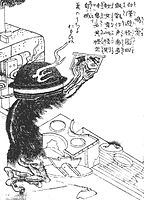 Narikama from the Gazu Hyakki Tsurezure Bukuro by Sekien Toriyama
Narikama from the Gazu Hyakki Tsurezure Bukuro by Sekien Toriyama
-
 Theatre Curtain with Yokai by Kawanabe Kyōsai (1880)
Theatre Curtain with Yokai by Kawanabe Kyōsai (1880)
Types
The folklorist Tsutomu Ema studied the literature and paintings depicting yōkai and henge (変化, lit. 'changed things/mutants'), dividing them into categories as presented in the Nihon Yōkai Henge Shi and the Obake no Rekishi:
- Categories based on a yōkai's "true form":
- Human
- Animal
- Plant
- Object
- Natural phenomenon
- Categories depending on the source of mutation:
- Mutation related to this world
- Spiritual or mentally related mutation
- Reincarnation or afterworld related mutation
- Material related mutation
- Categories based on external appearance:
- Human
- Animal
- Plant
- Artifact
- Structure or building
- Natural object or phenomenon
- Miscellaneous or appearance compounding more than one category
In other folklorist categorizations, yōkai are classified, similarly to the nymphs of Greek mythology, by their location or the phenomena associated with their manifestation. Yōkai are indexed in the book Sogo Nihon Minzoku Goi (綜合日本民俗語彙, A Complete Dictionary of Japanese Folklore) as follows:
- Yama no ke (山の怪) (mountains)
- michi no ke (paths)
- ki no ke (trees)
- mizu no ke (water)
- umi no ke (the sea)
- yuki no ke (snow)
- oto no ke (sound)
- dōbutsu no ke (animals, either real or imaginary)
History
Ancient history
- 772 CE: in the Shoku Nihongi, there is the statement "Shinto purification is performed because yōkai appear very often in the imperial court", using the word yōkai to not refer to any one phenomenon in particular, but to strange phenomena in general.
- Middle of the Heian period (794–1185/1192): In The Pillow Book by Sei Shōnagon, there is the statement "there are tenacious mononoke", as well as a statement by Murasaki Shikibu that "the mononoke have become quite dreadful", which are the first appearances of the word mononoke.
- 1370: In the Taiheiki, in the fifth volume, there is the statement, "Sagami no Nyudo was not at all frightened by yōkai."

The ancient times were a period abundant in literature and folktales mentioning and explaining yōkai. Literature such as the Kojiki, the Nihon Shoki, and various Fudoki expositioned on legends from the ancient past, and mentions of oni, orochi, among other kinds of mysterious phenomena can already be seen in them. In the Heian period, collections of stories about yōkai and other supernatural phenomena were published in multiple volumes, starting with publications such as the Nihon Ryōiki and the Konjaku Monogatarishū, and in these publications, mentions of phenomena such as Hyakki Yagyō can be seen.
The yōkai that appear in this literature were passed on to later generations. Despite the literature mentioning and explaining these yōkai, they were never given any visual depictions. In Buddhist paintings such as the Hell Scroll (Nara National Museum), which came from the later Heian period, there are visual expressions of the idea of oni, but actual visual depictions would only come later in the Middle Ages, from the Kamakura period and beyond.
Yamata no Orochi was originally a local god but turned into a yōkai who was slain by Susanoo. Yasaburo was originally a bandit whose vengeful spirit (onryō) turned into a poisonous snake upon death and plagued the water in a paddy, but eventually became deified as the "wisdom god of the well". Kappa and inugami are sometimes treated as gods in one area and yōkai in other areas. From these examples, it can be seen that among Japanese gods, there are some beings that can go from god to yōkai and vice versa.
Post-classical history

Medieval Japan was a time period where publications such as emakimono, Otogi-zōshi, and other visual depictions of yōkai started to appear. While there were religious publications such as the Jisha Engi (寺社縁起), others, such as the Otogizōshi, were intended more for entertainment, starting the trend where yōkai became more and more seen as subjects of entertainment. For examples, tales of yōkai extermination could be said to be a result of emphasizing the superior status of human society over yōkai. Publications included:
- The Ooe-yama Shuten-doji Emaki (about an oni), the Zegaibou Emaki (about a tengu), the Tawara no Tōda emaki (俵藤太絵巻) (concerning serpent/dragon-folk oppressed by a giant centipede yōkai), the Tsuchigumo Zoshi (土蜘蛛草紙) (about tsuchigumo), and the Dojo-ji Engi Emaki (about a giant snake). These emaki were about yōkai that come from even older times.
- The Kitano Tenjin Engi Emaki, in which Sugawara no Michizane was a lightning god who took on the form of an oni, and despite attacking people after doing this, he was still deified as a god in the end.
- The Junirui Emaki, the Tamamono Soshi, (both about Tamamo-no-Mae), and the Fujibukuro Soushi Emaki (about a monkey). These emaki told of yōkai mutations of animals.
- The Tsukumogami Emaki, which told tales of thrown away none-too-precious objects that come to have a spirit residing in them planning evil deeds against humans, and ultimately get exorcised and sent to peace.
- The Hyakki Yagyō Emaki, depicting many different kinds of yōkai all marching together
In this way, yōkai that were mentioned only in writing were given a visual appearance in the Middle Ages. In the Otogizōshi, familiar tales such as Urashima Tarō and Issun-bōshi also appeared.
The next major change in yōkai came after the period of warring states, in the Edo period.
Modern history
Edo period
- 1677: Publication of the Shokoku Hyakumonogatari, a collection of tales of various monsters.
- 1706: Publication of the Otogi Hyakumonogatari. In volumes such as Miyazu no Ayakashi (volume 1) and Unpin no Yōkai (volume 4), collections of tales that seem to come from China were adapted into a Japanese setting.
- 1712: Publication of the Wakan Sansai Zue by Terajima Ryōan, a collection of tales based on the Chinese Sancai Tuhui.
- 1716: In the specialized dictionary Sesetsu Kojien (世説故事苑), there is an entry on yōkai, which stated, "Among the commoners in my society, there are many kinds of kaiji (mysterious phenomena), often mispronounced by commoners as 'kechi.' Types include the cry of weasels, the howling of foxes, the bustling of mice, the rising of the chicken, the cry of the birds, the pooping of the birds on clothing, and sounds similar to voices that come from cauldrons and bottles. These types of things appear in the Shōseiroku, methods of exorcising them can be seen, so it should serve as a basis."
- 1788: Publication of the Bakemono chakutocho by Masayoshi Kitao. This was a kibyoshi diagram book of yōkai, but it was prefaced with the statement "it can be said that the so-called yōkai in our society is a representation of our feelings that arise from fear", and already in this era, while yōkai were being researched, it indicated that there were people who questioned whether yōkai really existed or not.
It was in this era that the technology of the printing press and publication was first started to be widely used, that a publishing culture developed, and was frequently a subject of kibyoshi and other publications.
As a result, kashi-hon shops that handled such books spread and became widely used, making the general public's impression of each yōkai fixed, spreading throughout Japan. For example, before the Edo period, there were plenty of interpretations about what the yōkai were that were classified as kappa, but because of books and publishing, the notion of kappa became anchored to what is now the modern notion of kappa.
Also, including other kinds of publications, other than yōkai born from folk legend, there were also many invented yōkai that were created through puns or word plays; the Gazu Hyakki Yagyō by Toriyama Sekien is one example. When the Hyakumonogatari Kaidankai became popular in the Edo period, it is thought that one reason for the appearance of new yōkai was a demand for entertaining ghost stories about yōkai no one has ever heard of before, resulting in some that were simply made up for the purpose of telling an entertaining story. The kasa-obake and the tōfu-kozō are known examples of these.
They are also frequently depicted in ukiyo-e, and there are artists that have drawn famous yōkai like Utagawa Kuniyoshi, Yoshitoshi, Kawanabe Kyōsai, and Hokusai, and there are also Hyakki Yagyō books made by artists of the Kanō school.
In this period, toys and games like karuta and sugoroku, frequently used yōkai as characters. Thus, with the development of a publishing culture, yōkai depictions that were treasured in temples and shrines were able to become something more familiar to people, and it is thought that this is the reason that even though yōkai were originally things to be feared, they have then become characters that people feel close to.
Meiji and Taishō periods
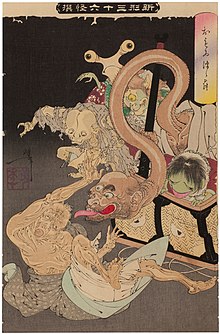
- 1891: Publication of the Seiyuu Youkai Kidan by Shibue Tamotsu. It introduced folktales from Europe, such as the Grimm Tales.
- 1896: Publication of the Yōkaigaku Kogi by Inoue Enryō
- 1900: Performance of the kabuki play Yami no Ume Hyakumonogatari at the Kabuki-za in January. It was a performance in which appeared numerous yōkai such as the Kasa ippon ashi, skeletons, yuki-onna, osakabe-hime, among others. Onoe Kikugorō V played the role of many of these, such as the osakabe-hime.
- 1914: Publication of the Shokubutsu Kaiko by Mitsutaro Shirai. Shirai expositioned on plant yōkai from the point of view of a plant pathologist and herbalist.
With the Meiji Restoration, Western ideas and translated western publications began to make an impact, and western tales were particularly sought after. Things like binbōgami, yakubyōgami [ja], and shinigami were talked about, and shinigami were even depicted in classical rakugo. Although the shinigami were misunderstood as a kind of Japanese yōkai or kami, they actually became well known among the populace through a rakugo called Shinigami by San'yūtei Enchō, which were adoptions of European tales such as the Grimm fairy tale "Godfather Death" and the Italian opera Crispino e la comare (1850). Also, in 1908, Kyōka Izumi and Chikufū Tobari [ja] jointedly translated Gerhart Hauptmann's play The Sunken Bell. Later works of Kyōka such as Yasha ga Ike [ja] were influenced by The Sunken Bell, and so it can be seen that folktales that come from the West became adapted into Japanese tales of yōkai.
Shōwa period
Since yōkai have been introduced in various kinds of media, they have become well known among people from all walks of life. The kamishibai from before the war, the manga industry, kashi-hon shops that continued to exist until around the 1970s, and television all contributed to the public knowledge and familiarity with yōkai. Yōkai play a role in attracting tourism revitalizing local mecca regions such as Tōno in Iwate Prefecture (where stories in Kunio Yanagita's Tono Monogatari were collected) or Tottori Prefecture (Shigeru Mizuki's birthplace).
In this way, yōkai are spoken about in legends in various forms, but traditional oral storytelling by the elders and the older people is rare, and regionally unique situations and background in oral storytelling are not easily conveyed. For example, the classical yōkai represented by tsukumogami can only be felt as something realistic by living close to nature, such as with tanuki (Japanese raccoon dogs), foxes and weasels. Furthermore, in the suburbs, and other regions, even when living in a primary-sector environment, there are tools that are no longer seen, such as the inkstone, the kama (a large cooking pot), or the tsurube (a bucket used for getting water from a well), and there exist yōkai that are reminiscent of old lifestyles such as the azukiarai and the dorotabō [ja].
As a result, even for those born in the first decade of the Shōwa period (1925–1935), except for some who were evacuated to the countryside, they would feel that those things that become yōkai are "not familiar" and "not very understandable". For example, in classical rakugo, even though people understand the words and what they refer to, they are not able to imagine it as something that could be realistic. Thus, the modernization of society has had a negative effect on the place of yōkai in classical Japanese culture.
On the other hand, the yōkai introduced through mass media are not limited to only those that come from classical sources like folklore, and just as in the Edo period, new fictional yōkai continue to be invented, such as scary school stories and other urban legends like kuchisake-onna and Hanako-san, giving birth to new yōkai. From 1975 onwards, starting with the popularity of kuchisake-onna, these urban legends began to be referred to in mass media as "modern yōkai". This terminology was also used in recent publications dealing with urban legends, and the researcher on yōkai, Bintarō Yamaguchi [ja], used this especially frequently.
During the 1970s, many books were published that introduced yōkai through encyclopedias, illustrated reference books, and dictionaries as a part of children's horror books, but along with the yōkai that come from classics like folklore, Kaidan, and essays, it has been pointed out by modern research that there are some mixed in that do not come from classics, but were newly created. Some well-known examples of these are the gashadokuro and the jubokko. For example, Arifumi Sato is known to be a creator of modern yōkai, and Shigeru Mizuki, a manga artist of yōkai, in writings concerning research about yōkai, pointed out that newly created yōkai do exist, and Mizuki himself, through GeGeGe no Kitaro, created about 30 new yōkai.
There has been much criticism that this mixing of classical yōkai with newly created yōkai is making light of tradition and legends. However, since there have already been those from the Edo period like Sekien Toriyama who created many new yōkai, there is also the opinion that it is unreasonable to criticize modern creations without doing the same for classical creations too. Furthermore, there is a favorable view that says that introducing various yōkai characters through these books nurtured creativity and emotional development of young readers of the time.
Comparison with yaoguai
Both the Chinese yaoguai and Japanese yokai include strange, supernatural beings with shapeshifting tendencies. In the Chinese version of the yaoguai, the emphasis is often on the first character 妖 yao, which connotes bewilderment and enchantment and supernatural affliction - for example, their ability to take on human form in order to seduce and to enthrall human beings. In the yokai, the emphasis appears to be on the 怪 guai, or on their monstrous and aberrant nature and anatomy. Japanese yokai in popular culture often includes elements of the cute, comical, the goofy, and the bizarre.
Some creatures appear in both Chinese and Japanese folklore as yaoguai and yokai, such as the scaly water shuihu (水虎), wilderness demons denoted as chimeiwangliang (魑魅魍魉), and nine-tailed fox demons (九尾狐).
Some, such as the nekomata (cat yokai) and tanuki (raccoon yokai), resemble Chinese yaoguai, which encompasses any number of shapeshifting animals and plants who have learnt to cultivate human form and other supernatural arts. The cat yokai, for example resembles the Chinese 仙狸 or "leopard cat immortal".
Yet others are uniquely Japanese, such as the ambivalent and occasionally cute kappa, the haradashi - a goofy yokai with its belly on its face, and the mumashika, which are comical-looking yokai with horse heads and deer bodies.
In popular culture
Further information: Category:Yōkai in popular cultureYōkai are often referred to as Japanese spirits or East Asian ghosts, like the Hanako-san legend or the story of the "Slit-mouthed girl", both of which hail from Japanese legend. The term yōkai can also be interpreted as something strange or unusual.
Lafcadio Hearn's collection of Japanese ghost stories entitled Kwaidan: Stories and Studies of Strange Things includes stories of yūrei and yōkai such as Yuki-onna, and is one of the first Western publications of its kind.
Yōkai remain prevalent in modern works of fiction. Shigeru Mizuki, the manga creator of such series as GeGeGe no Kitaro and Kappa no Sanpei, keeps yōkai in the popular imagination. Other popular works focusing on yōkai include the Nurarihyon no Mago series, Yu Yu Hakusho, Inuyasha: A Feudal Fairy Tale, Yo-kai Watch and the 1960s Yokai Monsters film series, which was loosely remade in 2005 as Takashi Miike's The Great Yokai War and more recently Yukinobu Tatsu 's Dandadan. They often play major roles in Japanese fiction.
See also
Japanese supernatural beings
- Kappa - a type of yōkai
- Oni - a type of yōkai
- Tengu - a type of yōkai
- Yōsei – Spiritlike creature from Japanese folklore, distinct from the yōkai
- Yūrei – Figures in Japanese folklore similar to ghosts, distinct from the yōkai
Japanese museums on the supernatural
Other supernatural beings from East Asian folklore
- Dokkaebi – Creatures from Korean folklore
- Ghosts in Chinese culture - Some Chinese ghosts are identical to the Japanese yūrei in character or nature
- Kijimunaa – Indigenous Ryukyuan belief system (legendary beings from the Ryukyu Islands)
- Mogui - A class of Chinese demons from Buddhism
- Yaoguai - A class of Chinese supernatural beings with shapeshifting abilities and other supernatural powers.
Lists of supernatural creatures from East Asian folklore
- List of legendary creatures from Japan – Legendary creatures and entities in traditional Japanese mythology
- List of supernatural beings in Chinese folklore - Legendary creatures and entities in Chinese folklore, many of which also recur in Japanese lore
References
Notes
- The index has the heading reikai (霊怪, "spirits and monsters"), under which reikai (霊怪), yōkai (妖怪), tsukimono (憑物, "possession by spirits").
- Picture books classed as a kusazōshi included further subcategories named after the colors of their jackets. A kibyōshi (yellow) referred to those catering to adult audiences; there were also akabyōshi (red) and aobyōshi (blue).
Citations
- Foster (2009), p. 13 " both of the graphs that signify yōkai, 妖, and 怪, carry the meaning of 'suspicious' or 'doubtful.'"
- Hirota (2021), p. 332.
-
Foster, Michael Dylan (14 January 2015). "Introducing Yōkai". The Book of Yōkai: Mysterious Creatures of Japanese Folklore. Oakland, California: University of California Press. pp. 20–21. ISBN 978-0-520-27102-9. Retrieved 14 September 2024.
although it is tempting to think in terms of a simple opposition - kami good and yōkai bad - the line between the two is blurry. Yanagita Kunio, the father of folkloristics in Japan, suggested that yōkai are kami that have 'degraded' over time, an idea that suggests an intimate relationship between the two. Folklorist-anthropologist Komatsu Kazuhiko has suggested that yōkai are 'unworshipped' kami and kami are 'worshipped' yokai. Both kami and yōkai reflect a way of thinking often called animistic, meaning that the things in the world around us - rocks, rivers, even musical instruments - can possess animating forces or spirits. Within such an animistic world, we can imagine a continuum. On one end, where yōkai cluster, we have everything that seems troublesome, undesirable, unworshipped. The other end contains helpful, desirable, and worshipped things - generally called kami. But these are extremes, and any individual entity can move along this continuum. If a 'bad' yōkai does something 'good,' we might consider it a kami, and vice versa.
- "Toriyama Sekien". Obakemono. The Obakemono Project. Archived from the original on 26 July 2013. Retrieved April 2, 2021.
- Komatsu (2015), p. 24.
- Komatsu (2011), p. 16.
- Miyata (2002), p. 14.
- Komatsu (2015), pp. 201–204.
- Komatsu (2011), pp. 16–18.
- Miyata (2002), pp. 12–14.
- Komatsu (2015), pp. 205–207.
- ^ Komatsu (2011), pp. 21–22.
- Komatsu (2011), pp. 188–189.
- Kondō, Mizuki; Saeki, Takahiro (2007), Saikaku to Ukiyoe zōshi kenkyū: dai-2-gō furoku. Kaiibutsu sashie taizen 西鶴と浮世草子研究 第二号付録 怪異物挿絵大全, Kasama shoin, ISBN 978-4-305-60202-2
- Minzokugaku kenkyujo (1956). Sōgō nihon minzoku goi 綜合日本民俗語彙. Vol. 5. Heibonsha. pp. 403–407.
- Komatsu (2011), p. 20.
- "Sonshō darani no genriki ni yorite oni no nan wo nogaruru koto" 尊勝陀羅尼の験力によりて鬼の難を遁るる事 [Escaping the oni by the spiritual power of the Vijaya Dharani], Konjaku monogatarishū 今昔物語集 (in Japanese), Book 14, No. 42
- Komatsu (2011), p. 78.
- Komatsu2011, p. 21.
- Komatsu (2015), p. 46.
- Komatsu (2015), p. 213.
- Miyata (2002), p. 12.
- Komatsu (2015), p. 200.
- Tachikawa, Kiyoshi (1987). Hyakumonogatari kaidanshū 百物語怪談集成. Kokusho Kankokai. pp. 365–367.
- "Sesetsu kojien 3" 世説故事苑 3巻. 1716. Retrieved 2015-12-16.
- Kabat, Adam ed., tr. (February 1999). Edo bakemono zōshi 江戸化物草紙. Shogakukan. p. 29. ISBN 978-4-09-362111-3.
- ^ Kyogoku, Natsuhiko; Tada, Katsumi, eds. (2008), Yōkaigahon kyōka hyakumonogatari 妖怪画本 狂歌百物語, Kokusho Kankokai, pp. 272–273, ISBN 978-4-3360-5055-7
- Yumoto, Kōichi (2008). "Asobi no naka no yōkai" 遊びのなかの妖怪. In Kōdansha Comic Create (ed.). DISCOVER yōkai: nihon yōkai daihyakka DISCOVER妖怪 日本妖怪大百科. KODANSHA Official File Magazine. Vol. 10. Kodansha. pp. 30–31. ISBN 978-4-06-370040-4.
- ^ Yamaguchi, Bintarō (2007). Hontō ni iru nihon no 'gendai yōkai' zukan 本当にいる日本の「現代妖怪」図鑑. Kasakura. p. 9. ISBN 978-4-7730-0365-9.
- "Toshi densetsu to yōkai" 都市伝説と妖怪. DISCOVER妖怪 日本妖怪大百科. Vol. 10. p. 2.
- ^ To gakkai (2007). Tondemo hon no sekai トンデモ本の世界. Rakkosha. pp. 226–231. ISBN 978-4-903063-14-0.
- ^ Yōkaiō (Yamaguchi Bintarō) Group (2003). Shōwa no kodomo: Natsukashi no yōkai zukan 昭和の子供 懐しの妖怪図鑑. Art Book hon no mori. pp. 16–19. ISBN 978-4-7747-0635-1.
- Mizuki, Shigeru (1974). Yōkai nandemo nyūmon 妖怪なんでも入門. Shogakukan. p. 17. ISBN 978-4-092-20032-6.
- "Japanese Yokai Meaning & List with Pictures of these Demons". Japan Avenue. Retrieved 2024-07-19.
- "Haradashi – Yokai.com". yokai.com. Retrieved 2024-07-19.
- "Mumashika – Yokai.com". yokai.com. Retrieved 2024-07-19.
Works cited
- Foster, Michael Dylan (2009). Pandemonium and Parade: Japanese Monsters and the Culture of Yōkai. University of California Press. ISBN 978-0-520-25361-2.
- Hirota, Ryūhei (2021). "Traversing the Natural, Supernatural, and Paranormal: Yōkai in Postwar Japan". Japanese Journal of Religious Studies. 48 (2, Religion and Identity in Japan since 1940): 321–340. doi:10.18874/jjrs.48.2.2021.321-339. JSTOR 27039930. S2CID 237709697.
- Komatsu, Kazuhiko (2011). Yōkaigaku no kiso chishiki 妖怪学の基礎知識 (in Japanese). Kadokawa gakugei shuppan. ISBN 978-4-04-703487-7.
- Komatsu, Kazuhiko (2015). Yōkaigaku shinkō: Yōkai kara miru nihonjin no kokoro 妖怪学新考 妖怪からみる日本人の心 (in Japanese). Kodansha. ISBN 978-4-06-292307-1.
- Miyata, Noboru (2002). 妖怪の民俗学 (in Japanese). Chikuma shobo. ISBN 978-4-480-08699-0.
Further reading
- Ballaster, Ros (2005). Fables of the East. Oxford University Press. ISBN 0-19-926735-9.
- Fujimoto, N. (2008). "Yôkai und das Spiel mit Fiktion in der edozeitlichen Bildheftliteratur" (PDF). Nachrichten der Gesellschaft für Natur- und Völkerkunde Ostasiens (in German). 78 (183–184). University of Hamburg: 93–104. Archived from the original (PDF) on 2022-02-19.
- Hearn, L. (2005). Kwaidan: Stories and Studies of Strange Things. Tuttle Publishing.
- Komatsu, K. (2017). An Introduction to Yōkai Culture: Monsters, Ghosts, and Outsiders in Japanese History. Japan Publishing Industry Foundation for Culture. ISBN 978-4-86658-049-4.
- Meyer, Matthew (2012). The Night Parade of One Hundred Demons. Matthew Meyer. ISBN 978-0-9852-1840-9.
- Phillip, Neil (2000). Annotated Myths & Legends. Covent Garden Books. ISBN 0-7513-3097-3.
- Tyler, Royall (1987). Japanese Tales. Pantheon Fairy Tale & Folklore Library. Random House. ISBN 0-394-52190-0.
- Williams, S. (2018). 妖怪の民俗学 [Silver Crossed Skies] (in Japanese). Frosty Snow Monk Publishing. ISBN 978-4-480-08699-0.
- Yoda, Hiroko; Alt, Matt (2012). Yokai Attack! The Japanese Monster Survival Guide. Tuttle Publishing. ISBN 978-4-8053-1219-3.
- Yoda, H.; Alt, M. (2016). Japandemonium Illustrated: The Yokai Encyclopedias of Toriyama Sekien. Dover Publishing. ISBN 978-0-4868-0035-6.
External links
- Yōkai and Kaidan (PDF; 1.1 MB)
- The Ōishi Hyōroku Monogatari Picture Scroll
- Database of images of Strange Phenomena and Yōkai (Monstrous Beings)
- Collection: Supernatural in Japanese Art, from University of Michigan Museum of Art